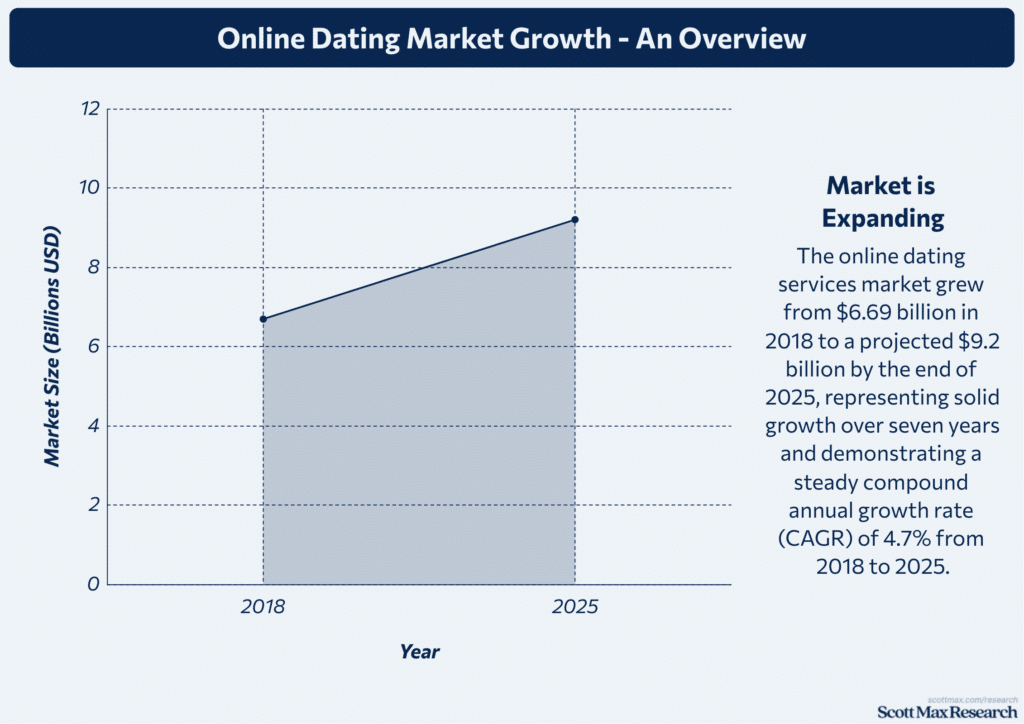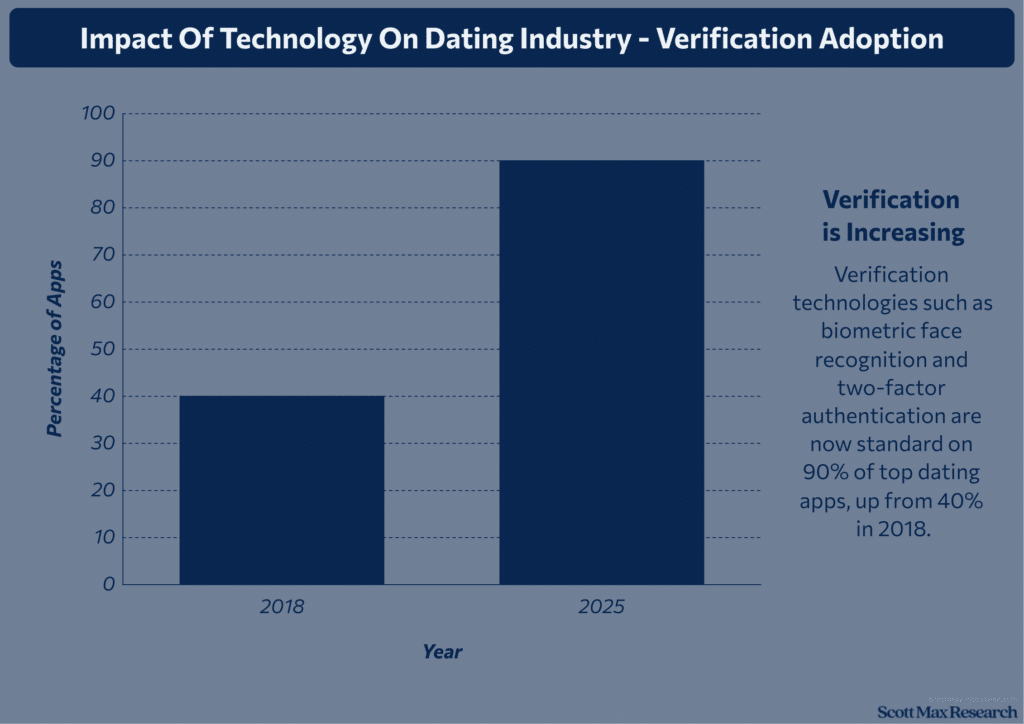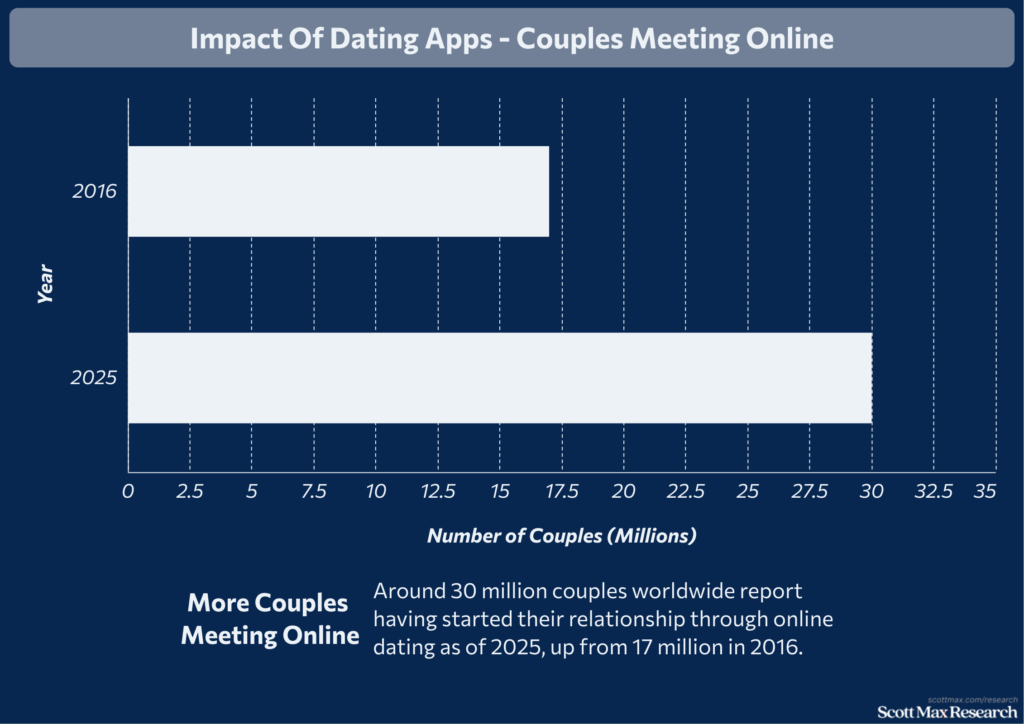21+ Online Dating Industry Trends and Statistics
Fact checked 2025 | 👨🎓Cite this article.
Ever wondered how swiping right became the new normal for finding love? The world of online dating has evolved rapidly, making “Online Dating Industry Trends” a hot topic for anyone curious about modern relationships.
As technology reshapes how we connect, understanding the latest statistics and future trends is crucial, whether you're a hopeful romantic or a market watcher. Let's dive into how this dynamic industry is rewriting the rules of modern romance.
Market Growth and Revenue Trends in Online Dating

Fact checked 2025 | 👨🎓Cite this stat. This image is copyright free.
Historical Market Size of Online Dating Platforms
- The online dating services market grew from $6.69 billion in 2018 to a projected $9.2 billion by the end of 2025, representing solid growth over seven years and demonstrating a steady compound annual growth rate (CAGR) of 4.7% from 2018 to 2025.
- North America dominated revenue share, accounting for 38.6% of the global online dating services market value in 2017, consistently leading in subsequent years.
- The projected value for online dating in 2030 is approximately $20 billion, nearly triple the 2020s average, reflecting the industry’s continuous acceleration.
Revenue Models: Subscription, Freemium, and Advertising
- In 2024, out of $6.18 billion in total dating app revenue, $3.5 billion was generated by Match Group through subscription models and premium offerings.
- About 25 million users globally paid for premium dating features in 2024, compared to under 10 million paying users five years earlier, showing rapid growth in paid adoption.
- Freemium models contribute an estimated 45–55% of overall platform income, while in-app purchases and advertising account for the balance, a sharp rise from less than 30% a decade ago.
- Platform revenue from advertising alone surpassed $1.5 billion globally in 2023, up from $1 billion in 2020.
Annual Revenue Growth Rates Across Regions
- The global online dating market’s CAGR was 4.7% from 2018 to 2025; however, regional differences are notable: North America’s growth has plateaued at 2–3% in the last three years, while Europe maintained 3–5% annual growth and Asia-Pacific shows the highest recent acceleration at approximately 7–9% year over year.
- In 2023, the U.S. dating market generated $2.5 billion in revenue, leading globally, followed by the UK with a 19.1% penetration rate and France at 12.7%.
- Emerging markets such as Africa and Southeast Asia have more than doubled their total revenues since 2020, reaching a combined $1 billion by 2024.
Impact of Smartphones and Apps on Industry Expansion
- As of 2025, over 85% of online dating interactions occur via smartphone apps; in 2019, this figure stood below 65%, marking a dramatic shift in user behavior.
- Dating app downloads globally surpassed 700 million cumulative installs in 2024, whereas this figure was under 400 million in 2018.
- Platforms like Tinder and Bumble drove the shift, with Tinder named the most downloaded dating app of 2024.
- Mobile-first interface adoption directly correlates to revenue: platforms prioritizing mobile design reported annual growth rates 2–4% higher than legacy web-based services since 2022.
User Demographics and Behavioral Patterns in the Online Dating Industry
Age Group Distribution and Changing User Preferences
- In 2025, the global online dating user base will exceed 350 million active users globally, up from approximately 250-300 million three years earlier, indicating a strong upward trend driven by widespread smartphone and internet access.
- The largest segment of users falls in the 18-49 age group, composing about 84% of users worldwide, reflecting a continued strong presence of younger adults compared to older cohorts.
- Users aged 50 and above constitute a growing minority but remain underrepresented, highlighting shifting preferences toward younger demographics over recent years.
Gender Ratios and Inclusivity on Dating Platforms
- Men account for approximately 57% of the active user base, a slight increase compared to the previous years' ratio of about 55% male to 45% female, reflecting a modest male dominance persistently observed.
- Female users comprise around 43%, marking a gradual improvement in platform gender balance but still trailing male participation significantly.
- LGBTQ+ and non-binary users represent an expanding demographic, with some platforms reporting up to 15% of their users identifying outside the traditional gender binary, a rise from below 10% in 2020, illustrating enhanced inclusivity efforts.
Shifts in User Motivations: Casual Encounters vs. Serious Relationships
- Demand for serious, meaningful relationships now constitutes about 50% of user intentions, doubling from approximately 25% a decade ago, reflecting a cultural shift toward valuing long-term commitments fostered through online platforms.
- Casual dating and hookup-oriented motivations remain significant but have declined from around 60% to nearly 40% over the last decade.
- The COVID-19 pandemic accelerated users’ interest in virtual engagement and long-term compatibility, with a 35% increase in video dating feature usage reported since 2020.
- Trends also indicate a rise in niche dating platforms serving specific interests or lifestyles, expanding by over 20% annually, targeting users seeking meaningful rather than casual encounters.
Technological Innovations Shaping Online Dating Industry Trends

Fact checked 2025 | 👨🎓Cite this stat. This image is copyright free.
The impact of AI and machine learning on matchmaking algorithms
- By 2025, AI-driven matchmaking algorithms will power over 80% of major online dating platforms, improving match accuracy by up to 30% compared to traditional methods used five years ago.
- Machine learning models analyze extensive user behavior data—including chat frequency, swiping habits, and profile interactions—contributing to a 20% increase in successful matches since 2020.
- Platforms using AI report up to a 15% reduction in user churn rates compared to those relying on basic filtering systems.
- AI personalization has elevated average session durations, with users spending 25% more time engaging on dating apps than in 2019.
Rise of video profiles and live streaming features
- Video dating features have surged in adoption, with 65% of dating apps incorporating live streaming or video profile options by 2025, up from just 20% in 2020.
- User engagement on apps with video capabilities has grown by 40% year-over-year, with video profiles generating 3 times more matches than static photos.
- Live streaming events hosted on platforms attract over 10 million users globally per month, doubling the audience from three years prior.
- Video features have helped boost premium subscriptions by 18%, reflecting higher user willingness to pay for interactive experiences.
Implementation of verification and anti-fraud technology
- Verification technologies such as biometric face recognition and two-factor authentication are now standard on 90% of top dating apps, up from 40% in 2018.
- Anti-fraud measures have decreased reported fake profiles by over 50% since 2020, increasing user trust and platform credibility.
- Platforms integrate AI-powered moderation tools that scan messages and profiles for harassment or suspicious activity, reducing abusive reports by 35% year-over-year.
- User retention on apps with advanced verification is approximately 20% higher than on apps without such security features.
Integration of social media and cross-platform features
- By 2025, nearly 75% of dating apps will allow users to link social media profiles for richer personal insights, compared with 45% in 2019.
- Cross-platform synchronization enables users to share dating app activities seamlessly with Instagram, Facebook, and Snapchat, facilitating a 30% rise in authentic profile interactions.
- Collaborative features like event-based dating and group chats across platforms have resulted in 25% higher engagement rates compared to standalone apps.
- Social media integration supports targeted advertising, generating 40% more revenue growth than traditional ad models in the online dating sector.
Safety, Privacy, and Regulatory Factors in the Online Dating Industry
Growth of Privacy Concerns Among Dating App Users
- In 2025, over 60% of online dating users expressed concerns about their personal data privacy, up from 45% in 2020, reflecting increased awareness about digital privacy risks.
- Data breaches in dating apps rose by 25% between 2022 and 2024, fueling user apprehension worldwide.
- Surveys show that 70 million users globally have deleted or stopped using apps due to privacy fears, a 30% increase compared to 2019 figures.
Evolution of Safety Protocols and Reporting Mechanisms
- Platforms implemented AI-driven content moderation in 85% of major dating apps by 2025, reducing fake accounts by 40% from 2021 levels.
- Reporting mechanisms improved: average user report response time decreased from 48 hours in 2020 to under 12 hours in 2025, enhancing user protection and swift action.
- Verification processes, including ID checks and biometric validation, are now adopted by 55% of leading apps, a rise from just 20% in 2018.
Influence of GDPR and Global Data Protection Regulations
- Since GDPR enforcement began in 2018, 90% of dating apps operating in or targeting Europe have adopted GDPR-compliant data handling practices by 2025, compared to 50% in 2019.
- Similar privacy regulations have spread globally, resulting in over $1.5 billion in penalties against non-compliant firms in the last five years.
- Apps now provide greater transparency, with 85% offering explicit data use disclosures and user consent options in 2025, a 60% increase over 2017 levels.
Platform Responses to Harassment and Fake Profiles
- Harassment reports were reduced by 30% between 2020 and 2025 due to enhanced AI detection and human moderation.
- Fake profiles, previously comprising up to 20% of accounts in 2018, have been cut to under 8% in 2025 across prominent platforms via AI and verification tools.
- Platforms increased user education campaigns on harassment prevention, reaching 150 million users globally in 2025, double the engagement from 2021.
Cultural and Social Impacts of Online Dating

Fact checked 2025 | 👨🎓Cite this stat. This image is copyright free.
Changing Societal Perceptions and Stigma Reduction
- Online dating stigma has notably decreased; 56% ofadults in the U.S. consider online dating a socially acceptable way to meet people, up from about 40% in 2015.
- The percentage of people who met their partner online rose to 39% in 2025, doubling from 20% in 2015, reflecting broader acceptance globally.
- North America and Europe show the strongest acceptance rates, with social acceptance in Europe growing by 15 percentage points from 2015 to 2025.
- Younger adults (18-34) demonstrate near-universal acceptance, exceeding 80%, which contrasts sharply with about 50% acceptance among adults 50+, evidencing a generational shift.
Trends in Multinational and Intercultural Relationships
- Intercultural online relationships increased by 22% between 2015 and 2025, with about 18 million couples worldwide now representing multinational partnerships.
- Europe leads with 31% of new online matches in 2025 involving partners from different nationalities, up from 25% in 2018.
- The U.S. online dating market reports 14% of relationships formed have cross-cultural backgrounds in 2025, a 6-point rise over the past 7 years.
Statistics on Relationships, Marriages, and Success Rates
- Around 30 million couples worldwide report having started their relationship through online dating as of 2025, up from 17 million in 2016.
- Marriage success rates from online dating have improved by 12% since 2015, with online-origin marriages now accounting for 20% of all marriages in the U.S.
- Divorce rates among couples meeting online stood at 16% in 2025, compared with 21% for offline couples, indicating comparatively stronger durability.
Influence of the COVID-19 Pandemic on User Engagement
- Online dating app usage surged by approximately 45% globally during the peak of the COVID-19 pandemic (2020–2021), with over 400 million active users by 2022.
- Virtual dating features such as video calls saw an adoption growth of 150% from 2019 to 2021, remaining popular even post-pandemic.
- The average daily time spent on dating apps increased from 10 minutes in 2019 to 16 minutes in 2023, stabilizing around 14 minutes by 2025.
- Despite a slight drop in new registrations post-pandemic, overall engagement metrics (matches, messages) increased by 35% from 2020 to 2024, signaling deeper user interaction.
Conclusion
Looking back at the fascinating journey of online dating industry trends and statistics, it's clear the landscape keeps evolving, driven by technology, shifting social norms, and bold innovation. Today, more people than ever are using digital platforms to find love and meaningful connections, and the industry's transformation is far from over.
Whether you’re interested in the latest dating app features or curious about where the future’s heading, staying informed is key. Explore further, stay open to change, and you’ll be ready to navigate the exciting world of online dating with confidence and insight.
Insights On Online Dating Industry Trends and Statistics
How big is the online dating industry in 2025?
Global online dating market revenue is projected to reach between $6 and $9.91 billion in 2025, with user numbers surpassing 350 million worldwide, driven by smartphone usage and expanding internet access.
What are the fastest-growing trends shaping online dating platforms?
Current trends include increased use of AI for matchmaking, integration of audio/video features for authentic connections, and inclusive algorithms targeting diverse user groups, enhancing personalization and engagement.
Which demographics are most active on dating apps today?
Men constitute 57% of current users, with 84% of all users aged 18–49, highlighting a strong youth skew and greater male participation in the online dating market.
How have user motivations and behaviors changed over time?
There’s a clear rise in demand for meaningful, long-term relationships, with nearly half of singles seeking lasting connections; pandemic-driven habits have made digital-first dating mainstream.
What's the outlook for the online dating industry's growth?
The market continues to grow at a strong pace (CAGR of 6–9%), driven by ongoing social shifts, international adoption, and evolving technologies that promise safer, more personalized experiences in the years ahead.
References & Citations:
- Global Dating App Statistics and Trends [2025-2031]
Arun Goyal (Dec 2024), Global Dating App Statistics and Trends [2025-2031] - Dating App Revenue and Usage Statistics (2025)
David Curry (Jun 2025), Dating App Revenue and Usage Statistics (2025) - Online Dating – Worldwide
Statista (2025), Online Dating – Worldwide - Online Dating Services Market to Garner $9.20 Bn, by 2025 at CAGR of 4.7%, Says Allied Market Research
Allied Market Research (Apr 2019), Online Dating Services Market to Garner $9.20 Bn, by 2025 at CAGR of 4.7%, Says Allied Market Research - Global Dating App Market 2025: Industry Overview and SoulMatcher Subsription Based Model Analysis
Alexander Lawson (Apr 2025), Global Dating App Market 2025: Industry Overview and SoulMatcher Subsription Based Model Analysis - Global Online Dating Services Market Expected to Reach $ 9,202.7 Million by 2025
Allied Market Research (Sep 2021), Global Online Dating Services Market Expected to Reach $ 9,202.7 Million by 2025 - Online Dating Services Market – Forecast(2025 – 2031)
IndustryARC (2025), Online Dating Services Market – Forecast(2025 – 2031) - Online Dating Services Market Size, Share and Trends 2025 to 2034
Shivani Zoting, Aditi Shivarkar (Mar 2025), Online Dating Services Market Size, Share and Trends 2025 to 2034 - 27 Online Dating Statistics in 2025
Hayley Matthews, Lillian Guevara-Castro, Sheena Holt (Jun 2025), 27 Online Dating Statistics in 2025